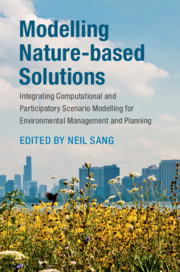 Modelling Nature-based Solutions
Modelling Nature-based Solutions Book contents
- Modelling Nature-based Solutions
- Modelling Nature-based Solutions
- Copyright page
- Contents
- Contributors
- Foreword
- Acknowledgements
- Introduction
- 1 Landscape Modelling and Stakeholder Engagement: Participatory Approaches and Landscape Visualisation
- 2 Agent-based Models of Coupled Social and Natural Systems
- 3 Modelling Nature-based Solutions from Soil Ecosystem Services
- 4 Modelling Water Resources for Nature-based Solutions
- 5 Models at the Service of Marine Nature-based Solutions
- 6 Coastal and Freshwater Flood Models: A Review in the Context of NBS
- 7 Nature-based Solutions to Urban Microclimate Regulation
- 8 Data Mining, Machine Learning and Spatial Data Infrastructures for Scenario Modelling
- 9 Can Geodesign Be Used to Facilitate Boundary Management for Planning and Implementation of Nature-based Solutions?
- 10 Integrating Models into Practice – Recommendations
- Appendix: List of Models/Software
- Index
- Plate Section (PDF Only)
- References
7 - Nature-based Solutions to Urban Microclimate Regulation
Published online by Cambridge University Press: 13 March 2020
- Modelling Nature-based Solutions
- Modelling Nature-based Solutions
- Copyright page
- Contents
- Contributors
- Foreword
- Acknowledgements
- Introduction
- 1 Landscape Modelling and Stakeholder Engagement: Participatory Approaches and Landscape Visualisation
- 2 Agent-based Models of Coupled Social and Natural Systems
- 3 Modelling Nature-based Solutions from Soil Ecosystem Services
- 4 Modelling Water Resources for Nature-based Solutions
- 5 Models at the Service of Marine Nature-based Solutions
- 6 Coastal and Freshwater Flood Models: A Review in the Context of NBS
- 7 Nature-based Solutions to Urban Microclimate Regulation
- 8 Data Mining, Machine Learning and Spatial Data Infrastructures for Scenario Modelling
- 9 Can Geodesign Be Used to Facilitate Boundary Management for Planning and Implementation of Nature-based Solutions?
- 10 Integrating Models into Practice – Recommendations
- Appendix: List of Models/Software
- Index
- Plate Section (PDF Only)
- References
Summary
Understanding the microclimate in a given site influences the preconditions of sustainable development in many ways. Cold and strong winds in the winter will, for example, intensify the energy use in buildings depending on the air tightness of the building enclosure (Bagge et al., 2011), and in areas close to the seafront strong salty winds may also increase the wear and tear on building materials. High wind speed during winter also affects outdoor recreation, and the likelihood of people walking or cycling to local commerce and social activities subsides if the area is subject to highly uncomfortable wind speed (Glaumann & Nord, 1993). Thermal comfort during winter time is thus integrated in how people will access and use facilities in their local communities. Wind turbulence and funnel effects between buildings and along streets also occurg to a greater extent in cities compared to rural settlements, although wind speed in general is stronger in the countryside (Oke, 1987), illustrating the importance of scale in modelling the urban environment. In Sweden, especially during winter time, strong winds help lower the air temperature by several degrees and thus contribute to uncomfortable physical conditions (Glaumann & Westerberg, 1988).
- Type
- Chapter
- Information
- Modelling Nature-based SolutionsIntegrating Computational and Participatory Scenario Modelling for Environmental Management and Planning, pp. 247 - 275Publisher: Cambridge University PressPrint publication year: 2020
